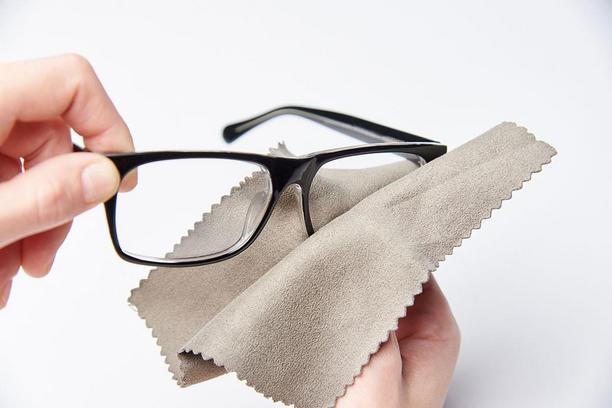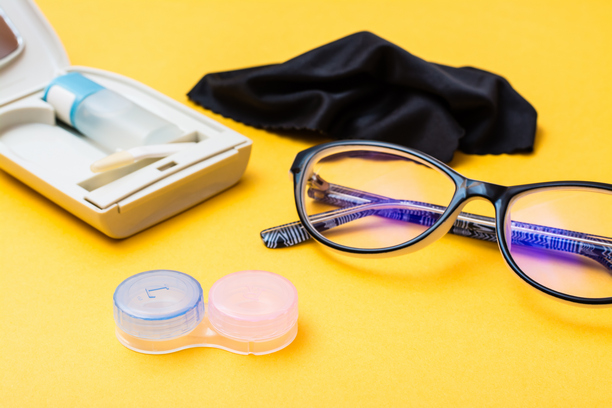- GlassesShop By FrameShop By StyleFeatured












Learn how to keep your prescription glasses in top condition for clear vision and long-lasting use. From cleaning methods to proper storage, this comprehensive guide has you covered.

Prescription glasses are indispensable for millions of people around the world who rely on them to see clearly. Many people may spend a lot of time choosing glasses frames and colors to ensure that they have the perfect eyewear picked to suit their face shape, style, and lifestyle. Once you put on your eyeglasses, you may not think too much about how to maintain them. However, caring for your prescription glasses and lenses does matter a lot.
There are many different varieties of eyeglasses. Some of the terms you might encounter include:
These are lenses with a single prescription change.
These are lenses with multiple prescriptions combined into a single lens. For example, a multifocal lens can have a prescription for close-up reading and another for seeing farther away.
These are a type of multifocal lenses. “Bi-“ means they contain two different prescriptions. They usually contain a visible seam/edge that separates the prescriptions (they often look like a lens within a lens).
These are also a type of multifocal lens. “Tri-“ means they contain three different prescriptions. These also usually have a seam between the different prescriptions, appearing like multiple lenses combined into a single piece.
These are somewhat like bifocals, but there’s no seam. The prescription gradually changes from top to bottom. The lower part of the lens helps with close-up vision.
These are single-vision lenses that help with near vision. Their main use is helping people with presbyopia see up close for tasks like reading.
These lenses shift the light’s position before it enters your eye. That position shift helps with double vision due to eye misalignment.
Sunglasses can have prescriptions built into the lens. This can be helpful if you need to wear glasses all the time and want to make it easier to block sunlight and see clearly at the same time.
These are also known as “light-adaptive” lenses. They automatically darken when ultraviolet light hits them. The material can be part of the lens itself or in a coating applied to the lens surface.
Properly caring for your prescription glasses and lenses can help them last longer and improve your vision:
Regular cleaning prevents smudges, oil, and debris from building up on your lenses, which can make it hard to see.
Proper care can extend the life of your glasses, including the frames. Frames that are well-cared for may be able to use replacement lenses.
Scratches and flaws on your lenses can affect your vision, causing eyestrain, headaches, or blurry vision.
Improper cleaning can damage the protective coatings on your lenses.

Following these guidelines will help you keep your prescription glasses in top condition, allowing you to see clearly and avoid unnecessary damage.Here are some tips for caring for your glasses:
Avoid abrasive tools and fabrics that can scratch your lenses.
Don't use rubbing alcohol, ammonia, bleach, or acidic ingredients like lemon juice or vinegar.
If you do use chemicals, use sprays or cleansers specifically made for eyeglass lenses.
Protect your glasses by storing them in a hard case.
Use a microfiber cloth to help dry your lenses, and avoid using t-shirts or paper towels.
To sum up, taking care of your prescription glasses and lenses is crucial for optimal visual performance, eye health, and durability. By adopting proper cleaning and storage practices, you can enjoy clear vision, comfort, and longevity from your eyewear investment. Use such a comprehensive guide to keep your prescription glasses intact and functional until you upgrade to your next pair!
Eyeglasses should be cleaned regularly, ideally once a day, but every one to two days will suffice. When cleaning your prescription glasses, you should be careful to use products that won't damage the glasses. Use warm water, a small drop of dish detergent, and a cotton or microfiber cloth.
Don't use household cleaners on your lenses. Many glasses and other surface cleaners contain ammonia which can damage your lenses and protective or anti-glare coatings. You should also avoid using paper towels, tissues, toilet paper, or napkins to clean your glasses, as they can scratch the lenses.
1. Use a hard case: A hard case protects your glasses from accidental breakage or being crushed. The case that came with your frames is usually the right size.
2. Lenses face upward: When placing glasses in a hard case, make sure that the lenses face upward.
3. Avoid overheating: Keep your glasses away from heaters and direct sunlight.
4. Avoid moisture: Store your glasses in a cool, dry place to prevent corrosion and mold growth.
5. Set them down carefully: Gently put your glasses down.
6. Clean regularly: Use a soft microfiber cloth and lens spray to clean your glasses regularly.
How to safely clean your glasses?
How to remove this green thingy inside my eyeglasses arm?
Latest Guide: How to Clean and Maintain Black Square Glasses?

